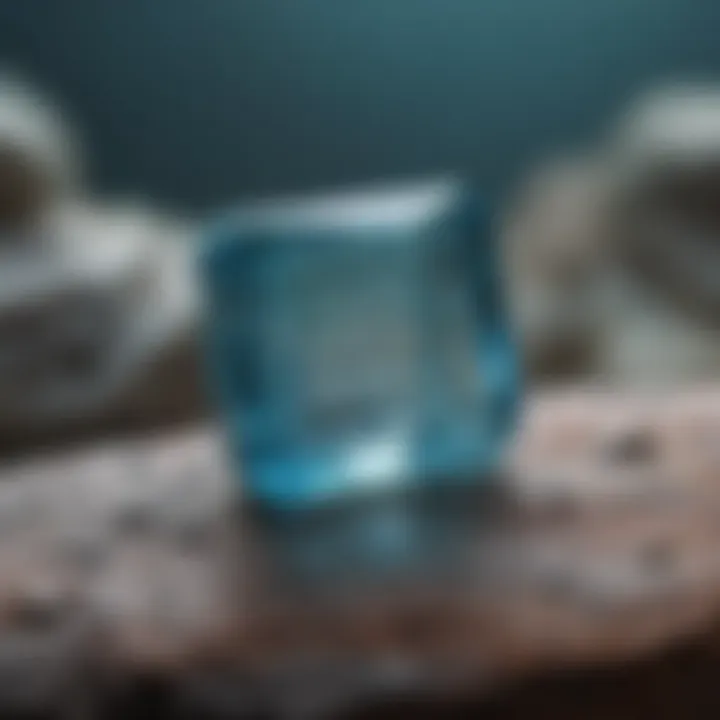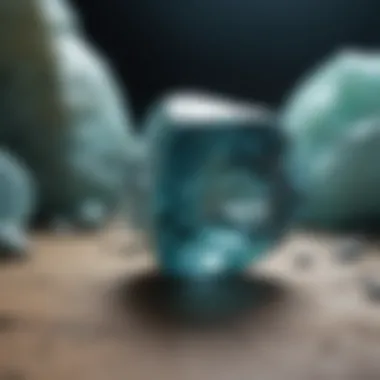The Stone Aquamarine: A Deep Dive into Its Wonders


Intro
Aquamarine, the enchanting blue or cyan variety of beryl, has captured the hearts and minds of many throughout history. With its calming hues reminiscent of tranquil waters, this precious stone embodies a connection between earth and ocean, a symbolism that transcends cultures. From ancient times, sailors revered it as a talisman against the perils of the sea, while today, the gem holds great significance in the world of collectors and jewelry enthusiasts.
In this exploration, we will uncover the geological formation of aquamarine, shedding light on how these beautiful stones come into being. We will traverse the annals of history to understand their significance in various civilizations, delve into their cultural symbolism, and examine practical applications ranging from jewelry to healing practices.
By dissecting its properties, mining practices, and challenges faced in the trade, this article aims to provide valuable insights tailored for rock and fossil collectors, hobbyists, and the discerning reader eager to expand their knowledge of aquamarine. Whether you’re seasoned in this field or just dipping your toes into the water, there’s plenty to discover in the vast ocean of aquamarine's allure.
Featured Collectible of the Month
Overview
Aquamarine is not merely a pretty face in the realm of gemstones; it's also a collectible that reflects intricate artistry and craftsmanship. Each stone reveals a story —from the location it was mined to the skilled hands that shaped it. This month, we are excited to spotlight Madagascar aquamarines, recognized for their intense colors and exceptional clarity that make them stand out in the market. The allure of owning such a gem often goes beyond aesthetics; it’s about the journey and the rarity behind the stone.
Historical Significance
Aquamarine has a multifaceted history, woven into the fabric of various cultures. In ancient lore, it was believed that the stone was formed from the tears of mermaids, offering protection to sailors during their voyages. The Romans dedicated this gem to Neptune, the god of the sea, further entrenching its maritime connotations. Many civilizations used aquamarine as an amulet, believing it fostered harmony and tranquility in relationships.
In the modern age, the charm of aquamarine remains untouched. For instance, in the late 19th century, Brazilian deposits of aquamarine began to emerge, revolutionizing the gemstone market. The striking blues captured the collective imagination, and it became a favored choice for engagement rings. Today, aquamarine is often associated with those born in March, symbolizing peace and courage.
"Aquamarine is like a stroll along a peaceful beach; it brings calmness and clarity to the chaos of life."
Identification Techniques
Visual Characteristics
Identifying aquamarine, with its vibrant tonal spectrum, can be both a thrilling and challenging endeavor. Here are some features to look out for:
- Color: Ranges from pale blue to deep blue; typically, more intense colors are deemed more valuable.
- Clarity: Ideally, aquamarine should be eye-clean, meaning no visible inclusions are seen without magnification.
- Cut: The quality of the cut can greatly influence the stone’s brilliance and overall appearance.
- Size: Larger stones are relatively rare and command higher prices.
Resources for Identification
To assist in identifying genuine aquamarine, several resources are available:
- Gemological Institutes: Organizations like the Gemological Institute of America (GIA) offer services to authenticate and grade gemstones.
- Online Forums: Platforms such as Reddit include communities where collectors share experiences and tips on identifying aquamarines.
- Books: Various literature, including encyclopedias on gemstones, provide in-depth knowledge on characteristics and identification methods.
In summary, aquamarine is not just a stone; it’s an emblem of legacy and craftsmanship. With every gem comes a tale, waiting to be discovered and cherished by those who dive into its depths.
Foreword to Aquamarine
Aquamarine is not just another gemstone; it holds a distinctive place in both the mineral world and the hearts of collectors and enthusiasts alike. Its serene blue hues often evoke the tranquility of water, which is fitting given its name that derives from Latin, meaning "water of the sea." This article embarks on a detailed journey through the multifaceted dimensions of aquamarine. The aim here is to empower readers with knowledge about this captivating stone, exploring its characteristics, origins, and significance across cultures and time.
Definition and Characteristics
Aquamarine is a variety of beryl, a mineral that comes in several colors, but it is the blue and greenish-blue shades that define aquamarine. What sets this gemstone apart is its remarkable clarity and its soothing colors reminiscent of ocean waters. A true aquamarine can range from a pale azure to a deep blue. The ideal specimen is often said to be a rich, vivid blue, without any heavy green undertones. The presence of iron in its composition is what gives aquamarine its unique hues.
Moreover, aquamarine belongs to the hexagonal crystal system, forming prismatic crystals that can sometimes reach impressive sizes. Stones that meet the gem quality standards can be cut into various shapes, particularly the classic emerald cut, which accentuates their brilliance. Indeed, many collectors prize aquamarines not only for their aesthetic quality but also for the impeccable craftsmanship involved in shaping them.
Chemical Composition
At the heart of aquamarine's beauty lies its chemical composition. Composed primarily of beryllium aluminum silicate ( Be3Al2Si6O18), the presence of trace amounts of iron provides the stone's alluring blue coloration. The variations in the iron content can influence the final color; higher levels typically yield deeper blues.
The beauty of aquamarine extends beyond its color. The stone's hardness, rated at 7.5 to 8 on the Mohs scale, adds to its durability, making it suitable for everyday wear in jewelry. This hardness allows the stone to resist scratches, thereby maintaining its exquisite finish longer than many softer gems.
In summary, understanding aquamarine involves an appreciation of both its visual allure and its scientific underpinning. This blend of aesthetics and chemistry is what continues to captivate rock and fossil collectors, enthusiasts, and jewelers alike. By diving into the world of aquamarine, one not only uncovers the stone's beauty but also its deep-rooted significance in various cultures and its geological importance.
Historical Context
Understanding the historical context of aquamarine is crucial for comprehending the stone's significance and its evolving role throughout human civilization. The rich narrative surrounding aquamarine not only reveals insights into ancient cultures but also reflects the gem's status as a coveted item through various ages. It has been a prized possession for many, intertwining with beliefs, traditions, and even commerce.
Origin of the Name
The name "aquamarine" comes from the Latin words "aqua" meaning water, and "marina" meaning of the sea. This etymology reflects the stone's captivating blue-green hues, reminiscent of tranquil ocean waters. Ancient sailors believed that aquamarine was a treasure of the mermaids, often used as a talisman for protection against storms while at sea. This lore not only speaks to the beautiful color of the gemstone but also to its historical role as a symbol of safety and hope.
The adoption of the name is attributed to its physical characteristics aligned closely with water and the sea. Traditionally, aquamarine stones were often carried in the pockets of fishermen, thought to ensure a bountiful catch and safe voyages. This connection to water is profound; as a result, many cultures even imbued aquamarine with the ability to calm emotions, fostering a sense of peace and tranquility. Its name thus encapsulates its dual nature as both a beautiful decorative gem and a significant cultural artifact.


Aquamarine in Ancient Cultures
Aquamarine has a longstanding place in various ancient cultures, where it served not just as an ornamental stone but as a vessel of deeper spiritual meaning and practical application. In Ancient Egypt, it was prized as a protective amulet, believed to ward off evil and promote safe travels. The Egyptians also used it as a burial stone, interring aquamarine with mummies to ensure safe passage to the afterlife.
In Roman mythology, aquamarine was associated with Neptune, the god of the sea. The Romans would don aquamarine jewelry as a way to invite Neptune's favor, ensuring safe navigation during their maritime endeavors. This gemstone was not only a symbol of beauty but a consequential part of maritime commerce and lore.
Meanwhile, in the Middle Ages, aquamarine symbolized purity and was often used in wedding rings. It was believed to bring love and happiness, making it an ideal choice for newlyweds seeking a blessed union. The lore continued to evolve, and during the Renaissance, aquamarine was embraced for its supposed healing properties, believed to cure ailments such as jaundice and improve the eyesight.
"Aquamarine has been a bridge between the terrestrial and celestial, symbolizing the link between humanity and the divine."
Indeed, this gemstone’s rich history reflects the varied ways it has been appreciated across different societies. Each culture gave aquamarine distinct qualities and significance, enhancing its allure and making it a favored stone among collectors today. With aquamarine bridging ancient beliefs to modern aesthetics, it holds a timeless significance that continues to captivate enthusiasts around the globe.
Geological Formation
The geological formation of aquamarine is a crucial aspect of understanding this precious stone. It lays the groundwork for its characteristics, such as color, clarity, and value. Knowing how and where aquamarine forms provides collectors and enthusiasts with hints about its quality and desirability. Additionally, recognizing the geological processes involved can inform better preservation methods, enhancing the longevity of these stunning gems.
Formation Processes
Aquamarine, a variety of the mineral beryl, begins its journey deep within the Earth. The formation processes can be quite intricate, relying on a few specific conditions. Here’s a breakdown of how aquamarine takes shape:
- Magmatic Formation: Aquamarine is primarily created from pegmatitic processes, which occur when magma cools slowly. As the magma crystallizes, it allows for larger mineral crystals, including aquamarine, to develop.
- Hydrothermal Activity: Once the magma is cooled, hydrothermal fluids rich in minerals seep through the cracks. These fluids bring additional ingredients needed for the formation of aquamarine, particularly traces of iron, which is essential for its blue hues.
- Metamorphic Conditions: In some regions, existing beryl can transform into aquamarine when subjected to extreme heat and pressure during metamorphic events. This can alter its color and clarity properties drastically, emphasizing the variety in aquamarine available to collectors.
Therefore, aquamarine formation isn't a one-trick pony; rather, it showcases a series of intriguing processes that can change its traits significantly. Understanding these underlying processes not only shapes appreciation for the stone but also guides collectors in their acquisition strategies.
Common Locations of Aquamarine Deposits
When it comes to finding aquamarine, certain geographical regions stand out. Identifying where these deposits are found can pique the interest of collectors, as the source often reflects the quality of the stone. Some notable locations include:
- Brazil: Often regarded as the leading country for aquamarine mines, particularly in Minas Gerais, where the stones are known for their rich color and size. Many collectors will tell you that Brazilian aquamarines are among the finest available.
- Nigeria: This West African nation has emerged as a significant source in recent years, producing vibrant stones. The emerald-like hues found in Nigerian deposits have gained traction in the market.
- Afghanistan: Known for its historical significance in gem trade, Afghanistan continues to yield high-quality aquamarine. The deposits here can reach incredible depths, producing stones that collectors cherish.
- Madagascar: This island nation has a diverse geology that leads to remarkable aquamarine specimens. Its geological wonders contribute to a variety of colors and sizes, appealing to collectors looking for unique stones.
In summary, the global tapestry of aquamarine deposits tells a story of the Earth’s geological history. Each location contributes its character, affecting the stone’s aesthetics and value, creating a treasure trove for aquamarine enthusiasts.
Physical Properties
Understanding the physical properties of aquamarine is essential for anyone invested in this striking gemstone. These attributes dictate how the stone interacts with light, its resilience, and overall allure. From gem enthusiasts to collectors, knowing these characteristics helps in evaluating the quality and potential value of aquamarine.
Color Variations
Aquamarine is primarily appreciated for its breathtaking shades of blue, reminiscent of clear ocean waters. Yet, the spectrum it offers is more varied than often realized.
- Blue Shades: Ranging from pale, almost watery blues to richer, deeper cerulean tones, the intensity and undertones differentiate quality grades. Stones with a darker, more vivid blue tend to command higher market values.
- Green Tints: Occasionally, you may find aquamarine exhibiting greenish hues. This phenomenon arises from the iron content during its formation. While still stunning, these variants are typically less sought after than their blue counterparts.
- Color Zoning: Some stones may even display color zoning, an attractive feature where different shades are visible. This unique trait can enhance visual interest and draw potential buyers, although it might complicate valuation.
Color plays a pivotal role in aquamarine’s desirability but remember, the most coveted hues are those without visible inclusions, allowing the light to dance freely through the gem.
Hardness and Durability
Aquamarine is no softy; rated 7.5 to 8 on the Mohs scale, it showcases considerable hardness. This makes it quite suitable for everyday wear. However, clarity should not be confused with toughness; while its hardness rating suggests resilience, the stone can still be susceptible to chipping or cracking when faced with rough handling or sudden impacts.
- Careful Handling: Ensuring that aquamarine is safeguarded during rigorous activities is advisable. For instance, removing rings or bracelets while engaged in physical tasks helps preserve the stone’s integrity.
- Scratch Resistance: Thanks to its hardness, aquamarine withstands minor scratches, which provides a layer of reassurance for daily wear. However, it’s always a wise choice to keep it away from harder stones.
- Cleaning Tips: Utilizing a soft cloth or a gentle soap solution for cleaning can help maintain its lustrous appearance without compromising its quality. Avoid ultrasonic and steam cleaners, as they may induce unnecessary stress on the stone and jeopardize its durability.
A stone's brilliance relies as much on its characteristics as on how well it is cared for. Regular maintenance can mean the difference between a dull rock and a gemstone that lights up the room.
These physical properties underline the significance of aquamarine in the jewelry domain and among collectors. Understanding how color variations and hardness influence desirability can greatly assist in making educated choices, ensuring that each aquamarine stone can be cherished for years to come.
Symbolism and Lore
The symbolism and lore surrounding aquamarine stretch far and wide, painting a vivid picture of how this beautiful stone has been perceived throughout centuries. This section dives into the multiple layers of meaning attached to aquamarine, showcasing both its spiritual significance and its presence in folklore and myths. Understanding these elements not only enriches our appreciation of aquamarine but also offers deeper insights into its enduring appeal among collectors and rock enthusiasts.
Spiritual Significance
Aquamarine has long been associated with tranquility and peace. Its gentle blue hues evoke images of calm seas, and many believe that the stone can instill harmony into one's life. For those in spiritual and holistic practices, aquamarine is often seen as a stone of courage and communication. It is thought to help clear the mind and facilitate clarity of thought, thus makng it suitable for decision-making processes.
- Calm and Serenity: Many spiritual practitioners advocate that aquamarine has the ability to ease fears and anxiety. Gazing at its serene color can transport individuals to a place of inner peace.
- Enhancement of Communication: Often connected with the throat chakra, aquamarine is believed to assist individuals in expressing themselves more clearly and confidently. This fosters not only better personal relationships but also enhances public speaking skills.
- Protection: In various cultures, sailors carried aquamarine stones for protection during their voyages. They believed that the stone could ward off dangers encountered at sea, symbolizing a beacon of safety while navigating challenges.
"Aquamarine is not just a gem; it is a guide, helping one navigate through the stormy seas of emotion and conflict."


Aquamarine in Folklore and Myths
The enchanting beauty of aquamarine has inspired numerous tales and legends across different cultures. These stories reflect the stone's significance beyond mere aesthetics and show how deeply embedded it is in human history.
- Mermaids and the Ocean: In ancient lore, aquamarine was said to be the treasure of mermaids. It was believed that they used the stone to lure sailors and enchant anyone who gazed upon it. This connection with the ocean reinforces the stone’s significance as a symbol of water and purity.
- Roman Beliefs: The Romans strongly valued aquamarine, associating it with Venus, the goddess of love. They believed that wearing aquamarine could rekindle love and strengthen relationships, which shows the enduring romantic significance of the stone.
- Healing Powers: Various cultures historically regarded aquamarine as a stone with healing abilities. It was used in rituals to cure ailments, particularly those related to the throat and voice. This tradition remains relevant today within certain healing practices.
The rich tapestry of aquamarine symbolism and lore illustrates not just its aesthetic value but its deeper connections to human emotional experiences and cultural beliefs. In the world of rock and fossil collecting, understanding these aspects can provide added layers of significance and appreciation for those who seek to engage beyond the surface shine.
Mining and Sourcing
The world of aquamarine is not just a treasure trove for collectors, it also involves a complex web of sourcing methods that directly impact its availability and value. Understanding the mining processes and responsible sourcing practices is critical for anyone keen on acquiring aquamarine gemstones. Mining provides the raw materials, while ethical sourcing ensures that these precious stones are obtained in a manner that respects both the environment and the communities involved.
Major Aquamarine Mines
Aquamarine can be found across the globe, but some regions are celebrated as the primary sources for top-grade stones. Here are a few notable mining areas:
- Brazil: This country is known for its rich deposits of aquamarine, particularly in Minas Gerais. The mines here consistently yield some of the largest and most vivid aquamarine crystals.
- Pakistan: In the northern regions, especially the Gilgit-Baltistan area, miners extract beautiful aquamarine from perilous mountain ranges. The unique geological conditions contribute to the stone’s crystal clarity and rich color.
- Nigeria: In the north, Nigeria has emerged as a significant aquamarine source. Mines here can produce a variety of colors and sizes, with local miners often utilizing artisanal methods.
Each of these locations contributes distinct socio-economic and environmental factors linked to the aquamarine trade. As collectors, it is vital to understand where your aquamarine comes from, as these origins not only affect value but can also signify quality.
Ethical Sourcing Practices
Ethical practices in sourcing aquamarine are gaining traction within the gem market. These practices ensure that stones are mined in a way that does not exploit people or destroy ecosystems. Here's what makes ethical sourcing particularly important:
- Community Development: Ethical sourcing often supports local economies by providing fair wages and improved working conditions for miners. This aspect can elevate the community’s quality of life.
- Environmental Conservation: Responsible mining methods reduce the ecological footprint left behind after extraction. Sustainable practices help preserve local flora and fauna, and mitigates loss of biodiversity.
- Transparency and Certification: Many buyers now seek assurance that their gemstones, including aquamarine, are sourced responsibly. Certifications from recognized organizations can validate ethical practices, giving collectors peace of mind.
“Knowledge is power, especially when it comes to ensuring the stones in your collection come from respected sources.”
As the demand for ethically sourced gemstones grows, it's vital for collectors and enthusiasts to ask questions and seek verification of the sources of their stones. By doing so, one actively supports the movement toward more responsible practices in the gem industry, enhancing not only personal integrity but also the broader health of the planet.
Aquamarine and Collecting
In the world of mineral collection, aquamarine holds a special place, radiating not just beauty but a distinct allure for both seasoned enthusiasts and those just dipping their toes into the hobby. Collecting aquamarine isn’t merely about acquiring stones; it’s a deep dive into the history, geology, and craftsmanship surrounding this stunning gem. Understanding aquamarine and its nuances can significantly enhance the overall experience.
How to Evaluate Aquamarine Stones
Evaluation of aquamarine stones involves several key factors. Recognizing these characteristics not only helps collectors determine a stone’s beauty but also its worth. Here's how one can evaluate:
- Color: The most sought-after aquamarine exhibits a vivid blue to slightly greenish-blue hue. The depth of color significantly impacts its appeal. Stones that show a vibrant, clear, and well-saturated blue are often regarded as high-quality.
- Clarity: Many aquamarines come with natural inclusions, but lesser inclusions increase a stone's value. The clarity can range from eye-clean (no visible inclusions) to heavily included (lots of internal features). Close examination under natural light can reveal hidden dimensions.
- Cut: Unlike diamonds, aquamarine can be cut in various styles. A well-cut stone not only enhances its clarity and brilliance but also allows the true color to shine through. Look for cuts that maintain the integrity of the stone while maximizing reflection.
- Carat Weight: Generally, larger stones command higher prices, but this factor should be balanced with the stone's other attributes. A smaller aquamarine of higher quality can be more valuable than a larger piece with diminished characteristics.
Evaluating aquamarine stones is an art—a balance of seeing the lore within the stone while appreciating its individual traits.
Authenticity and Certification
As with any collectible gem, authenticity is paramount in aquamarine trading. With increasing demand comes an alarming rise in counterfeit products. Every collector should remain vigilant about ensuring the authenticity of their acquisitions. Here are some essential considerations:
- Certification: When purchasing significant aquamarines, request certification from recognized gemological laboratories. Certificates typically provide details about the stone’s characteristics and confirm its authenticity. Reputable sources include the Gemological Institute of America (GIA), or the American Gemological Laboratories (AGL).
- Informed Sources: Engage with reputable sellers who can provide insight into their sourcing practices. Knowledge of the stone's origins and how it was mined can offer peace of mind regarding its authenticity.
- Visual Inspection: Familiarizing oneself with the visual elements of genuine aquamarine can make a significant difference. Being aware of its color patterns, clarity, and potential inclusions can help in distinguishing natural stones from synthetic ones.
- Community Validation: Engaging with fellow collectors on platforms like reddit.com or specialized facebook groups can provide insights and opinions on specific stones or vendors. The wisdom of a community can often mitigate the risks associated with new acquisitions.
"Collecting aquamarine can be a journey of passion and patience, where each stone tells a story long before it reaches your collection."
The significance of consistently evaluating authenticity leads to a more fruitful collection and helps in preserving the value of an often-complicated market. By equipping with knowledge on evaluation and certification processes, collectors stand a better chance of curating an impressive aquamarine collection.
Care and Preservation of Aquamarine
Caring for and preserving aquamarine is crucial not just from a collector's perspective, but also for the beauty and longevity of the stone itself. Like any precious item, aquamarine requires attention and regular maintenance to ensure that it retains its sparkling clarity and vibrant color. Proper care not only enhances its aesthetic appeal but can also contribute significantly to maintaining its resale value. Hence, let’s dive into some practical strategies and considerations for keeping aquamarine in top-notch condition.
Best Practices for Cleaning
Cleaning aquamarine is a delicate affair. Unlike some gemstones that can withstand harsh chemicals or extreme cleaning methods, aquamarine needs a gentle touch to maintain its shine. Here are some strategies to clean this captivating stone effectively:
- Use Mild Soapy Water: A mix of warm water and mild dish soap is often all it takes. Make sure to avoid any abrasive cleaners or tools.
- Soft Brush: Utilize a soft-bristled brush to gently scrub the stone. This helps in removing any dirt or grime without scratching the surface. Remember, a gentle hand will go a long way.
- Rinse Thoroughly: After cleaning, rinse the aquamarine thoroughly under lukewarm water to ensure that no soap residue is left behind.
- Drying: Pat the gemstone dry with a soft, lint-free cloth. Avoid rubbing as this might leave fine scratches.
Most importantly, aquamarine can be sensitive to extreme temperatures. Avoid exposing it to sudden temperature changes.
"Treat your aquamarine like a cherished friend, and it will shine brightly for years to come."


Storage Recommendations
Storing aquamarine correctly is just as vital as cleaning it. Proper storage helps prevent scratches, chips, or other forms of damage. Here are some insightful recommendations:
- Separate Storage: Always store aquamarine separately from other jewelry to avoid scratching. A fabric-lined box or a soft pouch works wonders.
- Avoid Direct Sunlight: Ultraviolet rays from the sun can fade the color over time. Store your aquamarine in a dark, cool place to help preserve its hues.
- Humidity Control: High humidity can lead to tarnish on metal parts of jewelry, which may indirectly affect the aquamarine. Keeping the environment dry can prevent potential issues.
- Regular Checks: Periodically check your stored aquamarine for any signs of wear or damage. Early intervention can prevent larger issues down the line.
Following these guidelines will not only help maintain the beauty of aquamarine but also ensure that these precious collectors’ items remain as stunning as the day they were acquired.
Market Trends
Understanding market trends in aquamarine isn't just a matter of cold hard numbers; it’s about reading the signs of this stone’s value and future potential. For collectors, enthusiasts or even investors, staying tuned to these shifts can spell the difference between a fortunate find and a costly mistake. The aquamarine market reflects broader economic conditions and unique fluctuations within the gem industry.
Current Valuation Factors
Current valuation factors of aquamarine stem from various aspects that influence its price. Here are some key elements worth considering:
- Color Intensity: The most sought-after aquamarines are those with a rich, vivid blue tone. Lighter shades often fetch lower prices, thus color remains paramount in determining value.
- Size and Clarity: Larger stones with fewer inclusions tend to command higher prices. A flawless, sizable aquamarine is like finding a needle in a haystack and it's reflected in the costs.
- Current Demand: Trends in jewelry design play a big role. For instance, if a famous designer features aquamarine in their collection, expect a spike in interest and prices.
- Rarity: Certain origins of aquamarine, such as those from Pakistan or Brazil, are considered more desirable due to limited availability. Collectors chase after stones with specific provenance.
- Market Sentiment: Keeping an ear to the ground about public perception and trends in gem collecting can provide insights. If aquamarine enjoys a surge in popularity thanks to social media influences, one might want to act quickly.
"In the world of gems, what’s in vogue can change overnight. Always do your research!"
Future Prospects in the Market
Looking ahead, the future of aquamarine in the market appears bright, yet it comes with its share of caveats. Factors to keep an eye on include:
- Sustainability Trends: More buyers are keen on ethical sourcing and environmentally friendly practices. Brands that can demonstrate these values may see greater demand for their aquamarine offerings.
- Technological Advances: Innovations in mining and processing can improve clarity and yield, potentially altering market dynamics. Better extraction methods mean more high-quality gems become available, but it might also affect scarcity and pricing.
- Shifts in Consumer Preferences: The younger generation often prioritizes unique, lesser-known stones. This could lead to a resurgence in aquamarine's popularity, but unpredictably so.
- Global Economic Influences: Economic stability or instability can sway buyer confidence, impacting purchases across the board.
- Cultural Revivals: Historical trends show that gems can make comebacks due to movie references or celebrity endorsements. If aquamarine sees such a revival, values could potentially soar again.
The aquamarine market remains a fascinating dance between tradition and modern preference, reflecting the currents of society at large. Keeping an eye on these trends can guide collectors in making informed decisions as they navigate the waters of aquamarine.
Challenges in Aquamarine Trade
The challenges faced in the aquamarine trade range from environmental concerns to issues relating to authenticity. As collectors and gem enthusiasts dive deeper into the aquamarine market, understanding these complexities becomes vital. Here, we explore two primary concerns: the environmental impact of mining activities, and the growing prevalence of counterfeit products.
Environmental Impacts of Mining
Mining for aquamarine, like other gem mining endeavors, brings along a hefty baggage of environmental challenges. The operations required to extract these stones often disturb local ecosystems. To shed some light:
- Habitat Destruction: The clearing of forests and land to establish mining sites can damage habitats for numerous flora and fauna. Some areas can take decades, or even centuries, to recover.
- Water Pollution: The process of mining can introduce harmful substances into local waterways. Chemicals used in extraction can seep into streams or rivers, affecting both aquatic life and the communities relying on those water resources.
"Environmental sustainability must not take a back seat in the pursuit of valuable stones like aquamarine. We need to think of future generations while enjoying our passions."
- Soil Erosion: With vegetation stripped away, soil becomes loose and easily washed away, contributing to erosion and further disrupting the natural balance.
Addressing these issues requires stakeholders to adopt more sustainable practices, balancing the scales between economic benefit and environmental responsibility. Efforts to reclaim mined land and restore natural habitats play a crucial role in mitigating these adverse effects, promoting responsible mining practices.
Counterfeit Aquamarine Products
As aquamarine continues to gain popularity among collectors, the threat posed by counterfeit products looms larger. The intersection of demand and deception can leave buyers blindsided, which is why awareness is key:
- Identifying Fakes: Different types of synthetic aquamarines exist, ranging from lab-grown varieties to doublets designed to mimic natural stones. It’s imperative for collectors to learn how to distinguish fake from real through visual inspections and, if necessary, gemological tests.
- Trustworthy Sources: Purchase from reputable dealers or certified gemstone shops. The gem trade is rife with scams, making it crucial to verify authenticity before parting with hard-earned cash.
- Certification: Obtaining a certificate from a recognized gemological laboratory can offer assurance regarding the stone’s authenticity. Without proper certification, buyers are likely to find themselves holding a counterfeit that was passed off as genuine aquamarine.
The End
When wrapping up a comprehensive exploration of aquamarine, it’s essential to reflect on its blend of beauty, science, and cultural significance. This stone is not just admired for its captivating colors and use in jewelry; it embodies a rich tapestry of history, symbolism, and craftsmanship. From discerning collectors to casual enthusiasts, understanding aquamarine’s attributes and background enhances its charm and value in the eyes of anyone who appreciates its elegance.
Recap of Key Insights
Throughout this journey, we’ve gathered a wealth of knowledge regarding aquamarine,
- Its formation and unique geological attributes ground its identity. Each stone carries the fingerprint of the earth, hinting at origins that span millennia.
- Historical relevance regarding its name and the fascination it held in ancient cultures revealed how deeply embedded it is in human experience. The belief that aquamarine offered protection for sailors highlights its thematic complexities.
- Specific insights concerning its physical properties emphasize why it distinguishes itself from other gemstones. Its tough but delicate nature appeals to both collectors and jewelers.
- Mining practices showcase the ongoing dialogue surrounding ethics and sustainability, which modern buyers increasingly prioritize.
- Through following market trends, we’ve anticipated how aquamarine stands at a crossroads, with dynamics shifting towards eco-conscious sourcing amidst increasing demand.
The Continued Relevance of Aquamarine
Aquamarine signifies more than just a precious stone. Its relevance carries through time, remaining a beloved choice in various contexts.
- For collectors, understanding authenticity and provenance is crucial. Familiarity with market trends equips enthusiasts with the tools to make informed decisions about buying and selling.
- Spiritually, its calming hues resonate with many seeking solace and clarity. In today’s hectic world, reconnecting with nature’s palette continues to inspire tranquility.
- As new generations take interest in gemology, aquamarine’s reputation as an accessible yet luxurious gem opens doors for both appreciation and investment.
Ultimately, studying aquamarine illuminates our connection to the natural world, reminding us how stones carry life’s stories while inviting us to engage with their legacy. The comprehension of aquamarine can transform its appreciation from a mere aesthetic selection to a meaningful possession, one that resonates with the heart and spirit.
"Aquamarine, with its sea-like tones, reflects both the wonders of our planet and its timeless connection to humankind."
The exploration of aquamarine is far from trivial; it offers a treasure trove of discoveries, ensuring that this gem will continue to capture imaginations for years to come.



